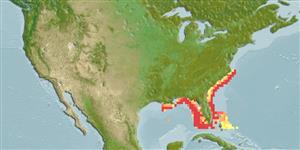Common names from other countries
Issue
Type locality: southern Florida and Pensacola, Florida.
Environment: milieu / climate zone / depth range / distribution range
Ecology
Marine; demersal; depth range 25 - 183 m (Ref. 5222), usually 60 - 120 m (Ref. 5222). Subtropical; 36°N - 24°N, 98°W - 62°W (Ref. 5222)
Western Atlantic: Bermuda and the coast of the USA from North Carolina to the Florida Keys and in the northern and eastern Gulf of Mexico. Reports from Cuba and the Bahamas are unsubstantiated.
Size / Weight / Age
Maturity: Lm ? range ? - ? cm
Max length : 110 cm TL male/unsexed; (Ref. 5222); max. published weight: 30.0 kg (Ref. 5222); max. reported age: 45 years (Ref. 93919)
Inhabits offshore rocky bottoms; most common between 60 and 120 m.
Life cycle and mating behavior
Maturities | Reproduction | Spawnings | Egg(s) | Fecundities | Larvae
Heemstra, P.C. and J.E. Randall, 1993. FAO Species Catalogue. Vol. 16. Groupers of the world (family Serranidae, subfamily Epinephelinae). An annotated and illustrated catalogue of the grouper, rockcod, hind, coral grouper and lyretail species known to date. Rome: FAO. FAO Fish. Synop. 125(16):382 p. (Ref. 5222)
IUCN Red List Status (Ref. 130435)
CITES (Ref. 128078)
Not Evaluated
Threat to humans
Harmless
Human uses
Fisheries: commercial; gamefish: yes
Tools
Special reports
Download XML
Internet sources
Estimates based on models
Preferred temperature (Ref.
115969): 17.7 - 25.2, mean 22.1 (based on 19 cells).
Phylogenetic diversity index (Ref.
82804): PD
50 = 0.5000 [Uniqueness, from 0.5 = low to 2.0 = high].
Bayesian length-weight: a=0.01122 (0.00653 - 0.01928), b=3.04 (2.90 - 3.18), in cm Total Length, based on LWR estimates for this species & Genus-body shape (Ref.
93245).
Trophic level (Ref.
69278): 4.0 ±0.6 se; based on size and trophs of closest relatives
Resilience (Ref.
120179): Low, minimum population doubling time 4.5 - 14 years (K=0.13; tmax=25).
Fishing Vulnerability (Ref.
59153): High vulnerability (62 of 100).
